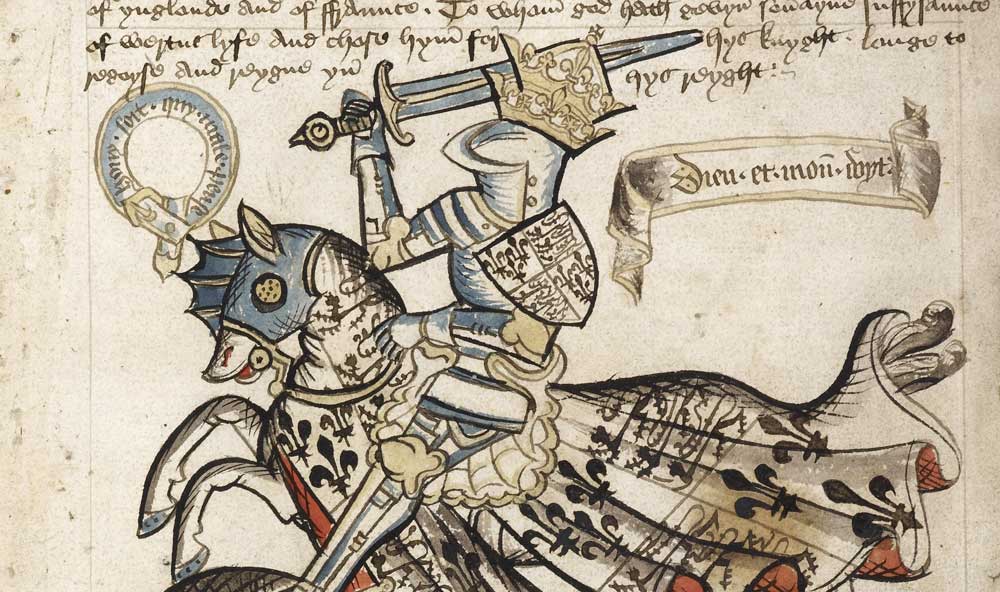Written in Heraldry | History Today - 4 minutes read

In the largely illiterate 14th to 17th centuries, heraldry could be read by all. As Victor Hugo wrote: ‘For those who can decipher it, heraldry is an algebra, a language. The whole history of the second half of the Middle Ages is written in heraldry.’
Heraldry proper consists of devices on a shield. A coat of arms is the design around that shield, typically – since the time of Henry VI – with real or mythological animal supporters and topped with decorative elements including a helm (helmet), coronet and crest.
That of the British royal family is perhaps the most familiar. On the mound at the base is the motto of English monarchs since 1413, ‘Dieu et mon droit’ (‘God and my right’), while the motto of the Order of the Garter, ‘Honi soit qui mal y pense’ (‘Shame be to him who thinks evil of it’) is inscribed on the garter around the heraldic shield. A crowned lion is the dexter supporter (dexter as it is the equivalent of stage right and so seen on the left by the viewer), while a unicorn is on stage left, or sinister. The lion conveys nobility and valour, the unicorn purity and virtue. Both mean courage and strength.
Just as heraldry is a language, a distinct code exists with which to describe it. There are the five heraldic colours: gules (red), vert (green), azure (blue), sable (black) and purpure (purple) and the two metals, argent (silver, from argentum) and or (gold, from aurum). French present participles describe the positions adopted by beasts. Lions rampant are erect with a hind paw on the ground, three other paws raised, tail lifted and head in profile. A lion guardant faces the viewer. A lion passant walks, with three paws on the ground, one raised and tail curving over his back. The arms of England, since Richard the Lionheart, have shown three lions passant guardant in pale or.
Such royal beasts can be seen on the moat bridge at Hampton Court, or on the roof of St George’s Chapel, Windsor, proclaiming royal ancestry. The yale, a mythical creature somewhere between an antelope and goat, was the symbol of Lady Margaret Beaufort, mother of Henry VII and the one through whom the Tudors’ tenuous claim to the throne was derived. Other fabulous beasts included dragons, wyverns (two-legged dragons), griffins or gryphons and cockatrice, with the head and legs of a cockerel, a long, barbed tail and the wings and scales of a dragon. Unicorns were not counted in this number because, until the 17th century, they were believed to exist, albeit elusively, as the horns of narwhales had often been found on seashores.
Badges or personal devices could convey values, aspirations, origins and loyalties. Katherine of Aragon’s crowned pomegranate symbolised fertility and abundance, but also – as the apple of Granada – her parents’ pious reconquista of southern Spain. Anne Boleyn’s badge on marriage to Henry VIII was a crowned falcon holding a sceptre on a tree stump, which sprouted red and white roses. The falcon symbolised one who restlessly pursued a much desired object, the sceptre royal authority, and the roses hope, joy and fecundity. Jane Seymour, meanwhile, bore a crowned phoenix rising from a castle between red and white roses: renewal, safety, the promise of heirs. Her adopted beast, the panther, reiterated the point; it signifies a beautiful woman who is tender and loving to her young.
The humour of the period meant that badges were often witty and enigmatic puns, known as ‘canting arms’. The Tudor portcullis plays on the name Beaufort – beautiful castle. Sir Nicholas Bacon’s personal device was a fat boar. The Quartermain family featured four hands on their shield, the Harrisons a hedgehog (hérisson in French). Even today Princess Beatrice of York has three bees – as ‘bees thrice’ sounds like Beatrice.
Heraldry, in other ways, inducts us into a way of thinking in the past. It connects the visual to the audible. Our ancestors thought wittily, laterally, poetically and creatively. Emojis have a way to go.
Suzannah Lipscomb is author of The Voices of Nîmes: Women, Sex and Marriage in Early Modern Languedoc (Oxford University Press, 2019), host of the Not Just the Tudors podcast and Professor Emerita at the University of Roehampton.
Source: History Today Feed